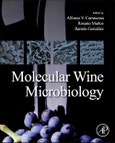Molecular Wine Microbiology features rigorous scientific content written at a level comprehensible for wine professionals as well as advanced students. It includes information on production and spoilage issues, the microbial groups relevant for wine production and microbial wine safety.
Microbiology has long been recognized as a key tool in studying wine production, however only recently have wine microbiology studies been addressed at a molecular level, increasing the understanding of how microbiology impacts not only the flavor quality of the wine, but also its safety. Understanding, at a molecular level, how a starter culture can impact ethanol, glycerol, volatile phenols, mannoproteins, biogenic amines or ochratoxin A of a wine are just some of the core points that must be considered in order to achieve maximium consumer acceptability while addressing safety concerns during processing and storage. While other books offer insights into the technological aspects of enology, this book is written by expert microbiologists, who explore the positive and negative impacts of gene function in the production of wine, from a microbiological point of view.
Please Note: This is an On Demand product, delivery may take up to 11 working days after payment has been received.
Table of Contents
Chapter 1. Yeast. Saccharomyces I. Yeast for primary alcoholic fermentationChapter 2. Yeast. Saccharomyces II. Second fermentation yeasts
Chapter 3. Yeasts. Saccharomyces III. Yeast for wines with biological ageing
Chapter 4. Yeast. Non-Saccharomyces
Chapter 5. Identification and molecular characterization of wine yeasts.
Chapter 6. Genomics and proteomics of wine yeasts.
Chapter 7. Improvement of wine yeasts by genetic engineering techniques
Chapter 8. Lactic acid bacteria.
Chapter 9. Acetic acid bacteria.
Chapter 10. Filamentous fungi
Chapter 11. Production of starter cultures for winemaking
Chapter 12. Conservation of wine related microbial strains
Chapter 13. HACPC in wine making. Ochratoxin A.
Chapter 14. Applied enological microbiology








